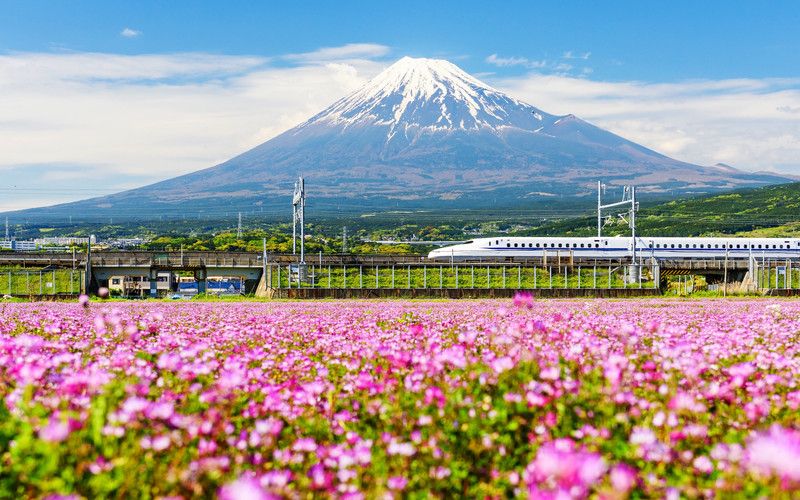The Tokaido Shinkansen, one of Japan’s famous bullet train lines, connects the cities of Tokyo and Yokohama, Nagoya, Osaka, and Kyoto. It’s the most-used Shinkansen line in Japan.
In 1964, it became the first high-speed rail line in the world. More than half a century later, the Tokaido Shinkansen line remains at the forefront of railway technology, with trains on the line reaching a top speed of 285 km/h.
It is also still tied to Japan’s rich history. The Tokaido is named after the main road that connected Japan’s former capital of Kyoto with its current capital of Tokyo during the Edo Period.
What do you need to know to navigate the Tokaido Shinkansen Line? You can do so easily and affordably using the JR Pass. This handy travel guide is here to help.
Table of Contents
Tokaido Shinkansen route and map
The Tokaido Shinkansen connects Tokyo with Shin-Osaka. There are 3 types of services that run on the route, Nozomi, Hikari, and Kodama, which you can see on the map below.
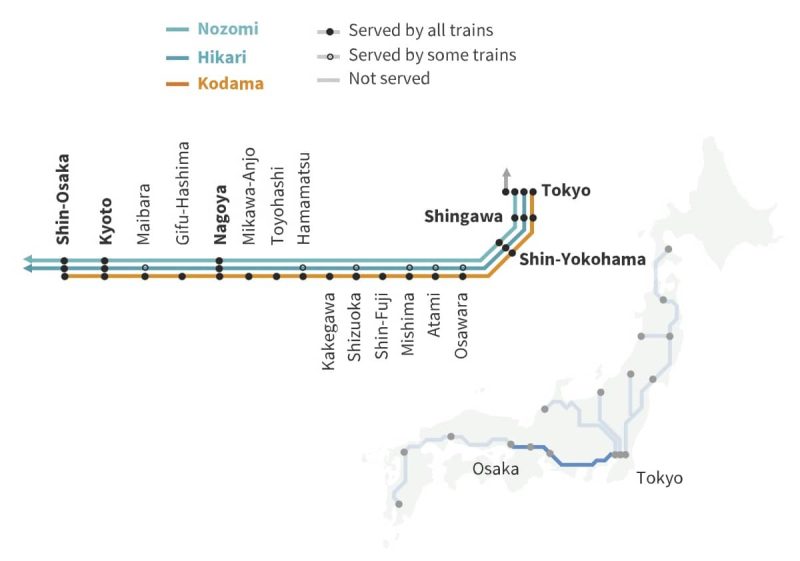
Tokaido Shinkansen stations
Stops on the Tokaido Shinkansen include Tokyo, Shinagawa, Shin-Yokohama, Odawara, Atami, Mishima, Shin-Fuji, Shizuoka, Kakegawa, Hamamatsu, Toyohasi, Mikawa-Anjo, Nagoya, Gifu-Hashima, Maibara, Kyoto, and Shin-Osaka Stations.
Find below a full list of stations the line stops at, as well as the connections you can make at each one.
| Station | Connections |
| Tokyo Station | Tohoku Shinkansen, Joetsu Shinkansen, Hokuriku Shinkansen, Yamagata Shinkansen, Akita Shinkansen, Yamanote Line, Chuo Main Line, Keihin-Tohoku Line, Tokaido Main Line, Tohoku Main Line (Utsunomiya Line), Takasaki Line, Joban Line, Keiyo Line, Yokosuka Line, Sobu Main Line, Tokyo Metro Marunouchi Line (M-17). |
| Shinagawa Station | Yamanote Line, Keihin-Tohoku Line, Tokaido Main Line, Yokosuka Line, Keikyu Main Line. |
| Shin-Yokohama Station | Yokohama Line, Yokohama Municipal Subway Blue Line. |
| Odawara Station | Tokaido Main Line, Odakyu Odawara Line, Izu-Hakone Railway Daiyuzan Line, Hakone Tozan Line |
| Atami Station | Tokaido Main Line, Ito Line. |
| Mishima Station | Tokaido Main Line, Izuhakone Railway Sunzu Line. |
| Shin-Fuji Station | |
| Shizuoka Station | Tokaido Main Line, Shizuoka Railway Shizuoka-Shimizu Line (Shin-Shizuoka Station). |
| Kakegawa Station | Tokaido Main Line, Tenryū Hamanako Line. |
| Hamamatsu Station | Tokaido Main Line, Enshu Railway Line (Shin-Hamamatsu Station). |
| Toyohashi Station | Tokaido Main Line, Iida Line, Meitetsu Nagoya Main Line, Toyohashi Atsumi Line (Shin-Toyohashi Station), Toyohashi Tramway (Ekimae Station). |
| Nagoya Station | Tokaido Main Line, Chūō Main Line, Kansai Main Line, Nagoya Subway Higashiyama Line (H08), Nagoya Subway Sakura-dori Line (S02), Nagoya Main Line (Meitetsu Nagoya Station), Kintetsu Nagoya Line (Kintetsu Nagoya Station), Aonami Line (AN01). |
| Gifu-Hashima Station | Meitetsu Hashima Line (Shin-Hashima Station). |
| Maibara Station | Tokaido Main Line, Hokuriku Main Line, Ohmi Railway Main Line. |
| Kyoto Station | Tokaido Main Line, Kosei Line, Nara Line, Sanin Main Line, Kintetsu Kyoto Line, Kyoto Municipal Subway Karasuma Line (K11). |
| Shin-Osaka Station | Sanyo Shinkansen (through service), Tokaido Main Line, Osaka Metro Midōsuji Line (M13). |
Tokaido Shinkansen timetable
Tokaido Shinkansen trains depart every few minutes from most stations along the route.
Four Hikari trains depart each hour, 2 in each direction. Departures take place approximately every half hour, and there’s around 3 hours of travel time between Tokyo Station and Shin-Osaka Station.
Additionally, 4 Kodama trains depart each hour, 2 in each direction. The trip from Tokyo Station to Shin-Osaka Station via Kodama train takes about 4 hours.
Eight Nozomi trains depart per hour – 4 in each direction – with additional trains running during peak hours. Nozomi trains reach Shin-Osaka Station from Tokyo Station in about 2 and a half hours.
The Tokaido Shinkansen timetable for the first and last trains that depart from Tokyo, and from Shin-Osaka, is as follows:
Tokyo to Osaka
| Stop | First train departure | Last train departure |
| Tokyo | 6:00 | 21:24 |
| Shinagawa | 6:07 | 21:31 |
| Shin-Yokohama | 6:18 | 21:42 |
| Nagoya | 7:35 | 22:58 |
| Kyoto | 8:09 | 23:32 |
| Shin-Osaka | 8:22 | 23:45 |
Osaka to Tokyo
| Stop | First train departure | Last train departure |
| Shin-Osaka | 6:00 | 21:30 |
| Kyoto | 6:14 | 21:44 |
| Nagoya | 6:49 | 22:18 |
| Shin-Yokohama | 8:05 | 23:33 |
| Shinagawa | 8:16 | 23:44 |
| Tokyo | 8:23 | 23:51 |
You can find the full, up-to-date timetable for the Tokaido Shinkansen on the JR Central official website.
The tickets
You can buy single Shinkansen tickets to ride the Tokaido line from ticket counters, ticket machines, or online through the official website.
The prices for an adult to ride some of the most popular routes on the Tokaido Shinkansen line are as follows:
| Route | Adult ticket price |
| Tokyo to Nagoya | 10,560 yen |
| Tokyo to Osaka | 13,870 yen |
| Tokyo to Kyoto | 13,320 yen |
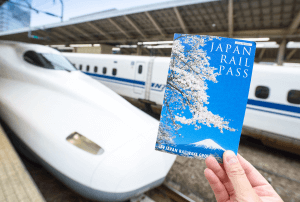

Unlimited access to transportation across Japan for 7, 14, or 21 days on:
- All Shinkansen trains
- Rapid and Local JR trains
- JR bus and ferry services
- Airport Transfers
A single ticket, huge savings.
Train Services
Below, you can find a breakdown of the 3 services that operate on the Tokaido Shinkansen line: Nozomi, Hikari and Kodama.
Hikari Shinkansen
Stops: Tokyo – Shinagawa – Shin-Yokohama – Nagoya – Kyoto – Shin-Osaka
Hikari trains represent the second-fastest option on the Tokaido Shinkansen line. Hikari trains serve more stations than do Nozomi trains but stop only at major cities, but these stops differ by train. Be sure to check train schedules carefully to ensure a stop at your intended destination.
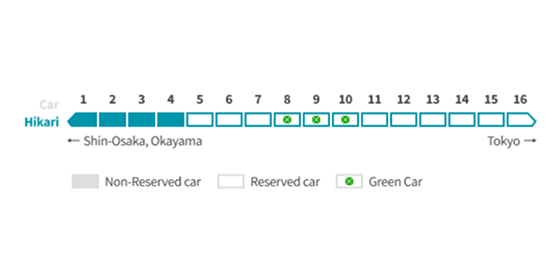
Kodama Shinkansen
Stops: Tokyo – Shinagawa – Shin-Yokohama – Odawara – Atami – Mishima – Shin-Fuji – Shizuoka – Kakegawa – Hamamatsu – Toyohashi – Mikawa-Anjo – Nagoya – Gifu-Hashima – Maibara – Kyoto – Shin-Osaka
Kodama Shinkansen trains stop at all stations along the Tokaido Shinkansen line. Some Kodama trains operating during the morning and evening rush hours offer only non-reserved seating. From Kodama trains, you may access famous hot spring towns not serviced by the other train types.
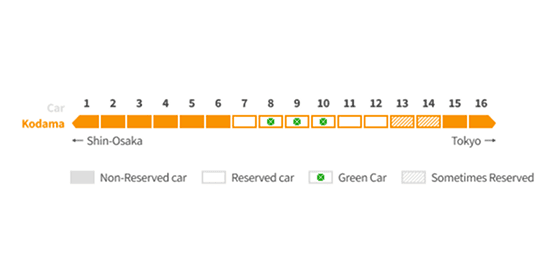
Nozomi Shinkansen
Stops: Tokyo – Shinagawa – Shin-Yokohama – Nagoya – Kyoto – Shin-Osaka
The fastest Shinkansen of the Tokaido Line. They stop only at major stations along the route, Some Nozomi trains continue on beyond the bounds of the Tokaido Shinkansen line.
Nozomi trains are partially covered by the JR Pass, you will need to pay a supplementary fee to ride.
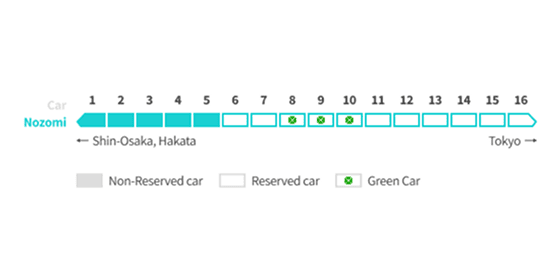
Private rooms (coming 2026)
In 2026, some trains on the Tokaido line will feature 2 private rooms.
If you’re traveling first-class, you can use one of these rooms. This means you’ll need to pay extra to use them if you are traveling with a JR Pass.
Japan Rail announced that these upgraded trains will be introduced “in order to meet the diversifying needs of customers due to changes in lifestyles and work styles.”
You might want to book a private room if you are any of the following:
- Businessperson wanting to have an online meeting
- Someone who needs privacy
- You need to relax in a space away from others
Private rooms will be equipped with:
- Doors to keep the room separated
- WiFi
- Reclining seats
- Air conditioning
- Adjustable lights
Covered by the Japan Rail Pass
The Tokaido Shinkansen line is fully covered by the JR Pass on Hikari and Kodama services.
However, as noted above, you need to buy a special complementary ticket to ride on Nozomi services. The price of this supplement is the same for ordinary class, first class (Green Car) and reserved and non-reserved seats, and is as follows:
| Nozomi Shinkansen supplement prices from Tokyo | |
| Nagoya | 4,180 yen |
| Kyoto | 4,960 yen |
| Shin-Osaka | 4,960 yen |
Common itineraries along the Tokaido Shinkansen line
Find below an outline of some of the most common trips you can take on the Tokaido Shinkansen:
- Tokyo to Yokohama: From Tokyo Station, take the Tokaido Line to Yokohama Station. This trip of 33 km will take just under half an hour. You may depart for your destination directly from Yokohama Station, or you may transfer to the Negishi Line to Kannai Station to reach the city center.
- Tokyo to Nagoya: From Tokyo Station, take the Tokaido-Sanyo Shinkansen to Nagoya Station. This trip over 347 km will take about 2 hours. From Nagoya, you will be able to travel to other major attractions, such as the Japanese Alps and the Kii Peninsula. Nagoya is also a gateway to other cities, such as Kyoto and Osaka.
- Tokyo to Kyoto: The 366 km of rail line from Tokyo to Kyoto represents Japan’s busiest. From Tokyo Station, you can take the Tokaido-Sanyo Shinkansen directly to Kyoto Station. This trip will take approximately 2 hours and 15 minutes.
- Tokyo to Osaka: From Tokyo Station, you can take the Tokaido-Sanyo Shinkansen directly to Shin-Osaka Station. This trip covers 514 km and will take just under 2 and a half hours.
